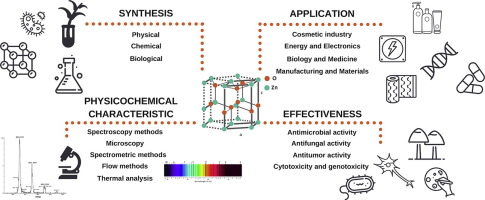Advances in Colloid and Interface Science ( IF 15.9 ) Pub Date : 2017-08-26 , DOI: 10.1016/j.cis.2017.07.033 A. Król , P. Pomastowski , K. Rafińska , V. Railean-Plugaru , B. Buszewski

|
Zinc oxide (ZnO), as a material with attractive properties, has attracted great interest worldwide, particularly owing to the implementation of the synthesis of nano-sized particles. High luminescent efficiency, a wide band gap (3.36 eV), and a large exciton binding energy (60 meV) has triggered intense research on the production of nanoparticles using different synthesis methods and on their future applications. ZnO nanomaterials can be used in industry as nano-optical and nano-electrical devices, in food packaging and in medicine as antimicrobial and antitumor agents. The increasing focus on nano zinc oxide resulted in the invention and development of methods of nanoparticles synthesis. Recently, various approaches including physical, chemical and biological (“green chemistry”) have been used to prepare ZnO nanocomposites with different morphologies. The obtained nanoparticles can be characterized with a broad range of analytical methods including dynamic light scattering (DLS), electron microscopy (TEM, SEM), UV–VIS spectroscopy, X-ray diffraction (XRD) or inductively coupled plasma with mass spectrometry (ICP-MS). With these it is possible to obtain information concerning the size, shape and optical properties of nanoparticles. ZnO NPs exhibit attractive antimicrobial properties against bacteria (Gram-positive and Gram-negative) and fungi. Zinc oxide nanocomposites show also selective toxicity toward normal and cancerous cells, which is explained by reactive oxygen formation (ROS). Yet despite the potentially interesting antitumor activity of ZnO nanoparticles, it has been proven that they can be also cytotoxic and genotoxic for multiple types of human cells (i.e. neuronal or epithelial cells). This paper reviews the methods of synthesizing zinc oxide nanocomposites as well as their characteristics, antimicrobial activity and cytotoxicity against normal and tumor cells.
中文翻译:

氧化锌纳米粒子:合成,防腐活性和毒性机理
氧化锌(ZnO)作为一种具有吸引人的性能的材料,在世界范围内引起了极大的兴趣,特别是由于实施了纳米尺寸颗粒的合成。高发光效率,宽带隙(3.36 eV)和大激子结合能(60 meV)引发了对使用不同合成方法生产纳米颗粒及其未来应用的深入研究。ZnO纳米材料可在工业上用作纳米光学和纳米电子设备,在食品包装中以及在药物中用作抗微生物剂和抗肿瘤剂。对纳米氧化锌的日益关注导致了纳米颗粒合成方法的发明和发展。最近,各种方法包括物理,化学和生物(“绿色化学””)已用于制备具有不同形态的ZnO纳米复合材料。获得的纳米颗粒可以通过多种分析方法进行表征,包括动态光散射(DLS),电子显微镜(TEM,SEM),UV-VIS光谱,X射线衍射(XRD)或电感耦合等离子体质谱(ICP) -多发性硬化症)。利用这些,可以获得关于纳米颗粒的尺寸,形状和光学性质的信息。ZnO NP对细菌(革兰氏阳性和革兰氏阴性)和真菌表现出有吸引力的抗菌性能。氧化锌纳米复合材料还显示出对正常和癌细胞的选择性毒性,这可以通过活性氧形成(ROS)来解释。尽管ZnO纳米粒子具有潜在的令人感兴趣的抗肿瘤活性,已经证明它们对于多种类型的人类细胞(即神经元或上皮细胞)也具有细胞毒性和遗传毒性。本文综述了合成氧化锌纳米复合材料的方法,以及它们对正常和肿瘤细胞的特性,抗菌活性和细胞毒性。











































 京公网安备 11010802027423号
京公网安备 11010802027423号